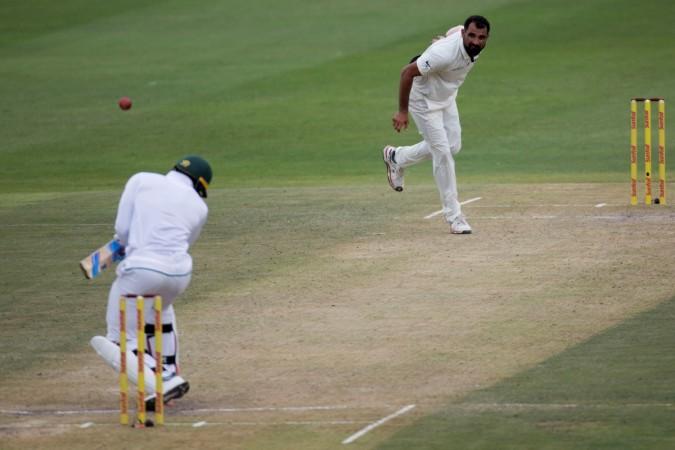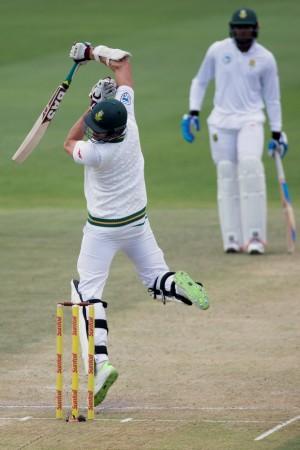
Right from the first day of the ongoing third Test between South Africa and India, the pitch has been under scrutiny. The batsmen, on both sides, have found it difficult to score runs. The Wanderers' wicket could face International Cricket Council's (ICC) wrath after the match referee submits his report.
India batted first on the grassy 22-yard surface and scored 187. Cheteshwar Pujara, who scored 50, said 187 was equal to 300 as conditions were tough. The hosts replied with 194. Both teams went in with all-pace attacks.
Also read: Pitch 'could be dangerous', says Bumrah
Yesterday (January 25), after the second day's player, India fast bowler Jasprit Bumrah said the pitch "could be dangerous" for batsmen.
During today's (January 26) play, captains Virat Kohli and Faf du Plessis were in discussion with the on-field umpires Ian Gould and Aleem Dar after Murali Vijay was hit by few deliveries.
On the first day, former India captain Sourav Ganguly called for ICC action and described the pitch as "unfair" for Test cricket.
Now an added element to this Test match. The pitch. We could be a matter of ‘couple of blows on the body’ away from this match getting called off.
— Sanjay Manjrekar (@sanjaymanjrekar) January 26, 2018
According to ICC regulations, "The objective of a Test pitch shall be to allow all the individual skills of the game to be demonstrated by the players at various stages of the match. If anything, the balance of the contest between bat and ball in a Test match should slightly favour the bowling team.
"A pitch should be expected to deteriorate as the match progresses, and as a consequence the bounce could become more inconsistent, and the ball could deviate more (seam and spin) off the wearing surface."
Match referee Andy Pycroft will file a report on the pitch and send it to ICC. The Johannesburg wicket is expected to be rated "poor".
So what are the ratings and sanctions for a Test pitch. Find out below.
As per ICC regulations the following apply
Test pitch ratings
Very good
Good carry, limited seam movement and consistent good bounce early in the match and as the pitch wears as the match progresses, with an acceptable amount of turn on the first two days but natural wear sufficient to be responsive to spin later in the game.
Good
Average carry, moderate seam movement and consistent bounce both early in the match and as the pitch wears as the match progresses, natural wear sufficient to be responsive to spin from day 1, though not quite meeting the criteria for carry and bounce for a "very good" pitch.
Average
Lacks carry, and/or bounce and/or occasional seam movement, but consistent in carry and bounce. A degree of turn, but with average bounce for the spinner. Falling significantly short of "very good" with respect to carry, bounce and turn.
Below Average
Either very little carry and/or bounce and/or more than occasional seam movement, or occasional variable (but not excessive or dangerous) bounce and/or occasional variable carry. If a pitch demonstrates these features, then the pitch cannot be rated in a higher category regardless of the amount of turn the pitch displays at any stage of the match.

Poor
A Poor pitch is one that does not allow an even contest between bat and ball, either by favouring the batters too much, and not giving the bowlers (seam and spin) from either team sufficient opportunity to take wickets, or by favouring the bowlers too much (seam or spin), and not giving the batters from either team the opportunity to make runs.
If any of the following criteria apply, a pitch may be rated "poor":
- The pitch offers excessive seam movement at any stage of the match
- The pitch displays excessive unevenness of bounce for any bowler at any stage of the match
- The pitch offers excessive assistance to spin bowlers, especially early in the match
- The pitch displays little or no seam movement or turn at any stage in the match together with no significant bounce or carry, thereby depriving the bowlers of a fair contest between bat and ball.
4. SANCTIONS FOR PITCHES AND/OR OUTFIELDS RATED BELOW AVERAGE, POOR OR UNFIT
4.1 It is expected that venues that are allocated the responsibility of hosting a Match will present the best possible pitch and outfield conditions for that match.
4.2 If the conditions are such that the Match Referee has cause to rate the pitch and/or outfield Below Average, Poor or Unfit, a corresponding number of Demerit Points will be imposed upon the Host Venue as per the table below.
(Read as Rating for Pitch and Outfield)
Very Good - Not Applicable, Not Applicable
Good - Not Applicable, Not Applicable
Average - Not Applicable, Not Applicable
Below Average - 1 Demerit Point, 0 Demerit Points
Poor - 3 Demerit Points, 2 Demerit Points
Unfit - 5 Demerit Points, 5 Demerit Points
4.3 Demerit Points will remain active for a rolling 5-year period.
4.4 Where a Host Venue accumulates a total of five (5) or more Demerit Points, the Host Venue will have its accreditation to host International Matches (at the point that the Host Venue first crosses the relevant threshold) suspended as follows.
5 Points – Host Venue accreditation will be suspended for a period of 12 months
10 Points – Host Venue accreditation will be suspended for a period of 24 months
4.5 Where a Host Venue has had both its pitch and its outfield in the same match rated Below Average, Poor and/or Unfit, the number of Demerit Points allocated will be the higher number as per the table above. For example, in one match, both the pitch and the outfield were rated as POOR. In accordance with the table above, that venue will be allocated 3 Demerit Points for that match (the maximum of 3 Demerit Points for the pitch, and not the 2 Demerit Points for the outfield).
4.6 In the event that a Host Venue has been allocated Demerit Points for the condition of its outfield, and that Host Venue has a number of subsequent fixtures scheduled over a short period of time, the Host Venue will need more time to improve the condition of its outfield than it would to produce a better pitch, so any subsequent Outfield Ratings within a period of 2 months after the initial rating will not add to the active Demerit Points for that Host Venue.









